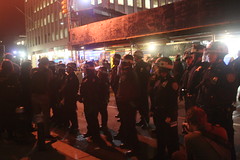
Republican presidential hopeful Newt Gingrich has a modest proposal: Put poor children to work cleaning their own schools and fire the unionized janitors who currently clean them.
“This is something that no liberal wants to deal with,” Gingrich said. “Core policies of protecting unionization and bureaucratization against children in the poorest neighborhoods, crippling them by putting them in schools that fail has done more to create income inequality in the United States than any other single policy. It is tragic what we do in the poorest neighborhoods, entrapping children in, first of all, child laws, which are truly stupid.
“You say to somebody, you shouldn’t go to work before you’re what, 14, 16 years of age, fine. You’re totally poor. You’re in a school that is failing with a teacher that is failing. I’ve tried for years to have a very simple model,” he said. “Most of these schools ought to get rid of the unionized janitors, have one master janitor and pay local students to take care of the school. The kids would actually do work, they would have cash, they would have pride in the schools, they’d begin the process of rising.” [POLITICO]
On Friday, Gingrich described child labor laws as “truly stupid,” which seems to imply that he wants to change them. Yet he later told Amy Gardner of the Washington Post that he doesn’t want to repeal child labor laws, he just wants to put poor kids to work as cut-rate janitors for 20 hours a week. There’s no indication that Gardner challenged Gingrich on this apparent reversal.
Newt also wants to abolish food stamps and public housing. His solution for changing the “culture of poverty” is to enlist poor kids as scullery maids while their more prosperous classmates enjoy free time. Newt predicts that enforced servitude will make the poor kids proud of themselves and their schools.
Rachel Weiner of the Washington Post describes Gingrich’s idea to replace janitors with poor kids as “unconventional,” which is an awfully generous way of putting it. She notes that, while other Republicans have flirted with relaxing wage and hour laws for teenagers, “Gingrich’s suggestion that children start working as early as age nine goes far beyond what most other Republicans are proposing.” Indeed.
Newt Gingrich is not a serious candidate. He is a buffoon and a meanspirited crank. He currently commands a bare plurality of support in the crowded race for the GOP nomination. He’s not the first fringe candidate to hog the spotlight while the Republicans work through their issues and crown Mitt Romney.
If Newt’s medieval policy proposals weren’t enough to discredit him, his checkered ethics record should count him out. His entire campaign staff already quit once. He’s just clawing his way back into the public eye to capitalize briefly on Hermain Cain’s slide in the polls.
As MSNBC’s Rachel Maddow famously explained, Gingrich has been flirting with running for president for decades. His “presidential ambitions” are just a marketing ploy to keep him relevant in the eyes of his lobbying clients and direct mail donors. After all, Newt can’t dine out on being the disgraced former Speaker of the House forever.
Why do the media insist on treating Gingrich’s campaign more seriously than he does?
[Photo credit: Gage Skidmore, Creative Commons.]











